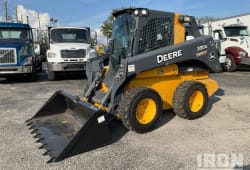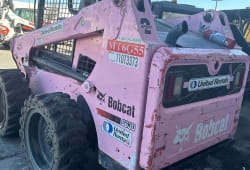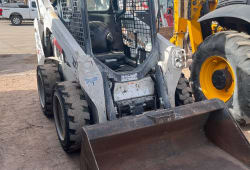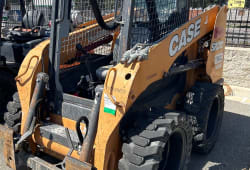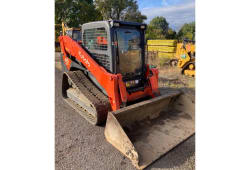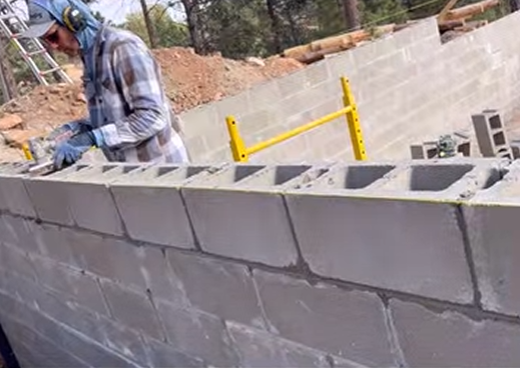Best 10 Tips for Operating a Skid Steer Loader Safely
7 Min read
)
May 30, 2023
Operating a skid steer loader requires a combination of skill, knowledge, and adherence to safety protocols. Whether you are a seasoned operator or you operate a skid steer as a beginner, prioritizing safety is essential to prevent accidents and ensure a productive work environment.
Ensure safe operations of skid steer loaders (skid steers) by obtaining training, wearing proper personal protective equipment, conducting inspections, and following safe loading/unloading practices. Consider using skid steers with steer attachments for enhanced versatility, such as those by John Deere Focus on safety and optimize performance.
What is a Skid Steer Loader?
:format(webp)) A skid steer loader, also known as a skid steer or skid loader, is a compact and versatile construction machine. It features a rigid frame, lifts arms, and a variety of attachments, such as buckets, forks, and augers. Skid steer loaders are primarily used for material handling, excavation, and landscaping tasks.
A skid steer loader, also known as a skid steer or skid loader, is a compact and versatile construction machine. It features a rigid frame, lifts arms, and a variety of attachments, such as buckets, forks, and augers. Skid steer loaders are primarily used for material handling, excavation, and landscaping tasks.
They are characterized by their ability to tilt and pivot on their own axis, enabling them to maneuver in tight spaces. With their small size operating weight, agility, and wide range of attachments, skid steer loaders are widely employed in construction, agriculture, and other industries for efficient and versatile operation.
What is a skid steer attachment?
A skid steer attachment is a specialized tool or accessory that can be connected to a skid steer loader. These attachments are designed to enhance the capabilities and versatility of the full skid loader or steer, allowing it to perform a wide range of tasks beyond its standard functions. Skid steer attachments come in various types and designs, including:
1. Buckets
2. Forks
3. Grapples
4. Augers
5. Brush cutters
6. Trenches
7. Snowblowers
10 Tips for Operating Skid Steer Loader Safely
Skid steer loaders are versatile machines. They are widely used in industries like construction, agriculture, and landscaping. These machines offer speed and utility. Safety must be prioritized during skid steer loader operations. It helps prevent accidents and injuries.
Tip#1 Wear Proper Personal Protective Equipment (PPE)
One of the first and most crucial steps in operating a skid steer loader safely is wearing appropriate personal protective equipment (PPE). PPE protects operators from potential hazards that can cause severe injuries, such as falling objects, flying debris, and contact with moving parts of heavy equipment. Remember the following key points:
1. Importance of wearing PPE
Wearing the correct PPE is critical for operator safety, as it can significantly reduce the severity of injuries and even save lives. Before operating a skid steer loader or trailer, ensure you are wearing the necessary PPE.
2. Examples of PPE to wear when operating a skid steer loader:
When operating compact track loaders or skid loaders, it's essential to wear proper PPE for safety. This includes a hard hat to protect against falling objects, safety glasses or goggles for eye protection, earplugs or earmuffs to reduce noise exposure, steel-toed boots for foot protection, and high-visibility clothing to enhance visibility.
Remember to always wear your seat belt and use the safety bar for added safety. Proper PPE can prevent serious injuries and ensure your well-being.
Tip#2 Conduct a Pre-Operation Inspection
Before operating a skid steer loader, it is crucial to perform a pre-operation inspection. This inspection ensures the machine's safety and helps identify any potential hazards or issues. Consider the following key points:
Importance of inspecting the skid steer loader before the operation
Inspecting the part operating a skid steer loader before the operation is crucial for safety. It helps identify mechanical issues and hazards, preventing accidents. Items to check, include:
Tires/tracks
Hydraulic components
Oil/fuel level
Battery
Lights
Seat belt
Controls
Thorough inspections ensure machine safety and reduce the risk of accidents.
Tip#3 Know the Skid Steer Loader Controls
Before operating a skid steer loader, familiarizing yourself with the controls is vital. Here are the basic controls and two key points to remember:
Skid steer loader controls
The controls, such as the steering wheel or joystick, accelerator and brake pedals, lift arm controls, and attachment controls, are typically located in the rear of the cab in the operator's cab. Knowing the location and function of each control is necessary for safe operation.
Importance of understanding control operation:
Knowing how to safely operate the controls is crucial for the operator and worksite safety. Incorrect use can lead to accidents or injuries. Preoperational familiarity with the controls helps prevent accidents, ensures proper machine use, and improves efficiency.
Read the operator's manual and receive training to understand the controls before operating a skid steer loader. Understanding the machine and operating weight's capabilities and limitations enhances safe and efficient work.
Tip#4 Follow the Guidelines of Skid Steer Loaders
To operate skid steer loaders safely, it is crucial to follow the manufacturer's guidelines and safety protocols provided in the operating manual. These handbooks contain important information and instructions specific to the machine, including:
Safety precautions
Operating procedures
Maintenance guidelines
Adhering to these guidelines helps prevent accidents and ensures the proper functioning of the equipment. Always read and follow the instructions in the handbook to operate skid steer loaders safely and efficiently.
Tip#5 Keep the Load Low
Keeping the load low during skid steer loader operation is crucial for safety and accident prevention. Consider the following key points:
Importance of Keeping the load low
Maintaining a low load is vital for stability and safety while operating a skid steer loader. Elevated loads raise the machine's center of gravity, increasing the risk of tipping. Keeping the load low enhances stability and minimizes accidents and tipping incidents.
Tip#6 Be Aware of Your Surroundings
Maintaining awareness of your surroundings while operating a skid steer loader is paramount for worksite safety. Consider the following key points:
Being mindful of your surroundings is critical to prevent accidents and injuries when operating a skid steer loader
Operators must know the positions of coworkers, equipment, and obstacles to avoid collisions or mishaps.
They should also remain vigilant about potential hazards like uneven terrain, slopes, and overhead power lines, ensuring safety for themselves and others.
Tip#7 Hazards to watch out for when operating a skid steer loader:
Here are examples of hazards that must attention when operating a mini skid steer loader:
Overhead power lines
Unstable or loose ground
Unstable surfaces like water or mud
Blind spots or limited visibility
Debris or obstacles on the worksite
Tip#8 Avoid Overloading the Skid Steer Loader
To ensure safety and prevent accidents:
Overloading can lead to instability and tipping, risking injuries to the operator and others on the worksite. Increased risk of accidents or injuries from tipping over. The added strain on components potentially damages the machine and reduces its lifespan. Decreased maneuverability and control, compromising safe operation. Possible fines for violating weight restrictions.
Tip#9 Use Attachments Properly
Using attachments correctly is crucial for safe and effective skid steer loader operation. Using the wrong attachment or using one improperly can damage the machine, create hazards, and cause injuries to operators and others on the worksite. Various attachments are available for skid steer loaders, such as:
Buckets for digging and moving materials
Forks for lifting and moving pallets
Augers for drilling holes
Grapples for handling large objects
Sweepers for surface cleaning
Snowplows for snow removal
By following manufacturer instructions and safety guidelines, operators ensure the safety and efficiency of their work, preventing accidents and injuries.
Tip#10 Conduct Regular Maintenance Checks
Regular maintenance checks are crucial to ensure the skid steer loader's safety, reliability, and longevity. They help identify and address issues early on, preventing costly repairs and accidents, and ensuring efficient and safe operation. Perform the following maintenance checks:
Check engine oil, hydraulic fluid, and fuel levels before each use.
Inspect tires for wear and damage.
Verify brake system condition, including fluid level and pads.
Inspect hydraulic hoses for leaks or damage.
Check lights, signals, and safety features.
Operators perform regular maintenance checks to ensure the skid steer loader's safety. These checks also promote reliability, efficiency, and extended lifespan. They help prevent accidents and minimize downtime.
Conclusion
Operating a skid steer loader safely requires knowledge, awareness, and adherence to safety practices. This article provides tips for operators to follow. They should wear PPE, inspect the machine, and use attachments properly. By doing so, they can reduce accident risks, protect themselves and others, and improve worksite productivity.
When operating a skid steer loader with vertical lift, it is crucial to familiarize yourself with loader arms, bucket controls, and the machine's operating capacity to ensure safe and efficient operation.

